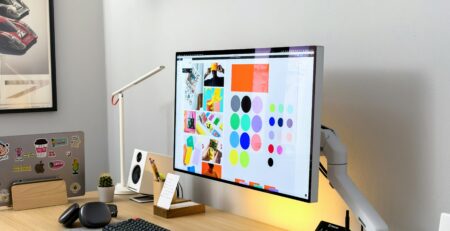Mobile-First UX Design: How To Make It Remarkable
It’s wild how much our smartphones have become a part of our lives nowadays. We’re on these little devices from morning till night, checking messages over breakfast, finding directions during our commute, or streaming our favorite shows before bed. With mobile taking the lead, it’s super important to make sure your apps and websites are actually pleasant to use, especially since there are hundreds of apps competing for users’ attention each day. The answer lies in focusing on user experience, which we’ll discuss in this guide.
What Is Mobile-First UX Design?
Have you noticed that more and more people are using their smartphones instead of computers? That’s because mobile devices like phones and tablets have become many people’s primary way of accessing the internet and apps.
Mobile-first UX design is all about recognizing this shift and making sure your app or website works best for mobile users first before anything else. UX stands for “user experience,” which is all the feelings someone gets from using an app or website, whether they find it easy, fun, or frustrating.
When you design mobile-first, you start by thinking about how your app or site will look and work on a small screen like a phone rather than a computer. You need to optimize everything from the layout, menus, and buttons so they are perfect for touching with your fingers.

You must also consider that mobile internet connections can sometimes be slower than WiFi. So, you design pages that load fast without needing huge photos or videos each time. Little things like only showing a few menu options at once instead of a long list make it less overwhelming.
Ultimately, the goal is to create a smoother experience that people enjoy using on their most accessible device: their phone. This approach meets users where they are already spending most of their time online.
Importance of Mobile-First UX Design
Nowadays, almost everyone has a smartphone, and people use their phones for all kinds of things instead of just computers. In fact, studies show the average person checks their phone over 150 times every day. If your app isn’t optimized for phones, people might get frustrated and not bother using it. So, in this section, we’ll look at some key reasons why practicing mobile-first UX design matters.
People Use Their Phones More Than Computers
These days, most people have a computer at home or work that they can use. But computers are big and not as portable as phones. Phones, on the other hand, fit right in your pocket, so you can take them everywhere, from school, on the bus, even in the bathroom. Because of this, people rely on their phones more than computers now.
Statistically, phone use has massively increased over the past few years while computer use has decreased. On average, people spend up to 4 hours daily on their phones. So, if an app or website doesn’t work well on mobile phones, users might get frustrated and not use it. They’ll just choose something else that is optimized for their most-used device instead.
It Increases Your SEO Performance

Since Google and other search engines want users to have a good experience, so they prioritize websites optimized for mobile. When your site loads quickly on phones and is easy to use with taps, search engines see that as providing value to mobile users. They’ll rank your pages higher so more people can easily find what they need from their phones.
But search engines may move down the results if your site is slow or glitchy on phones. They don’t want users to have frustrating experiences. Mobile users will also leave your site faster if it’s hard to navigate with a touchscreen. Mobile-first helps you build pages that meet search engine standards for speed, usability, and responsiveness on phones.
It Provides a Better User Experience on the Devices
The main goal of any design, whether for an app, website, or anything else, should be to give users an enjoyable experience. However, experiences can vary a lot between devices like phones versus computers.
Phones have smaller screens that you control with your fingers instead of a mouse. Connection speeds might change when you’re on data compared to WiFi. And people use phones differently, like when they’re on the go, compared to being at home.
If you design with phones as the priority from the start, you can tailor every aspect specifically for mobile users. Users notice and appreciate designs that seem thoughtfully crafted for their devices. They won’t get annoyed by hard-to-tap buttons or frustrated waiting for pages to load.
It Provides Smoother Navigation
Navigation is very important for any great user experience, but it can be really tricky on a tiny phone screen compared to a computer. This is why mobile-first UX focuses on navigation so users can easily zip around your app or site no matter where their fingers land.
Connections can also vary a lot more on mobile. Sluggish loading prevents smooth navigation, which can frustrate users and cause them to abandon your creation. If you carefully optimize your design, it shaves seconds off transitions. Hence, the flow feels fast and fluid even on slower data. Usability testing on actual phones also helps identify any parts of navigation that don’t quite work, as well as on bigger screens.
It Helps Businesses Reach More People and Keep Customers Happy
The main goal of any business is to attract customers and keep them coming back. And in today’s world, people spend more and more time on their mobile devices instead of traditional computers. So, if your business wants to reach the widest possible audience, it needs to have a strong mobile presence.
Designing mobile-first helps businesses connect with more potential customers right on their phones. By optimizing for mobile from the start, your company website or app is accessible to anyone with an internet connection, no matter where they go. This exposes your brand and products to a huge worldwide market. And iCreatives can connect you with the right professionals for whatever mobile-first UX project you have.
But getting people’s attention is only half the battle. To grow your customer base, you also need to keep the ones you reach satisfied so they return in the future. Mobile-first UX ensures users have seamless, trouble-free experiences whenever they engage with your company from their phone.
How To Make Your Mobile-First UX Design Remarkable
Just designing an app or site to work on phones isn’t enough. You want people to absolutely love using what you’ve made. And since there are so many choices out there, you need your creation to stand out from the crowd. In this section, we’ll provide some tips that the most popular apps use to craft truly remarkable mobile experiences.
Start With the User
The most important person to focus on when designing anything is the user. But on mobile, this is especially true since people interact with apps in very personal ways. To make an experience truly remarkable, you must understand users inside and out.
Start by thinking about who will be using your app and why. What goals will they be trying to accomplish? What do they like or dislike? One way to learn this is by interviewing potential users and watching how they use similar apps now.
It’s also wise to test early designs with a sample of users. This gives you honest feedback to improve the design before spending too much time coding. Seeing where users get confused helps you fix issues before launch.
Keep It Simple
Space is limited on a phone, so your designs must be clean and uncomplicated. Too many buttons, menus, or features crammed into a small screen look messy and confuse users. Simple, minimalist designs are remarkably appealing on mobile.
You want the main goal of your app to be accomplished in three taps or less from any screen. Extra steps and sub-menus can frustrate people and make them leave. This is why popular apps always prioritize immediately obvious main functions over unnecessary extras.
By focusing designs down to their purest forms, users can instantly grasp your app rather than getting lost in overwhelming complexity. Streamlined experiences make your design professional compared to overloaded messes.
Make Your Website Fast
Speed is incredibly important for any website but critical for mobile users. When people are on their phones, they have limited data or may be on a slow public network. If pages take too long to load, users will leave your site in frustration before it even starts.
When designing mobile-first, you need to optimize your site for fast performance. Some key things to focus on are minimizing page size by compressing images. You should also avoid unnecessary redirects that make loading sluggish.
Caching is another excellent technique, as it saves content from previous visits so repeat users can instantly access these pages without waiting. Meanwhile, ensuring your code remains efficient over time is just as important.
Use Big and Easy Buttons
On a mobile screen, finger taps are different than using a mouse on a computer. So, the size and spacing of buttons matter a lot more. Small or tightly packed buttons are tough to hit with fingertips reliably.
That’s why using large, spread-out buttons is essential for mobile interfaces. They need to be big enough to easily press even while holding an unsteady phone. Big buttons that are well-spaced mean fewer accidental misses and resizing around the screen.
Not only are bigger buttons easier to press, but they also make the purpose clear at a glance. Large graphics or text labels sum up what each tap achieves instantly. This way, there’s no confusion over what actions may occur.
Have a Well-Defined Content Hierarchy Based On the User’s Needs
When designing for mobile, you have limited screen space, so presenting content needs to be thoughtful. You want users to quickly find what they’re looking for without wasting taps. To do this well, you need a clear content structure.
You can start by using research to understand users’ core tasks and information needs. Then, organize all content to directly support these key goals and questions. Anything extra should be deprioritized.
Also, group related pieces logically together. Use section headings, menus, and progressive disclosure of sub-points to avoid clutter. Users should be able to scan through your design and deduce the hierarchy. The result allows users to drill down and back up as required effortlessly. This beneficial content presentation leaves a great impression that user experience was the top priority in design.
Consider One Hand Use

Almost all mobile interactions happen with just one hand holding the device. So it’s important to design with that in mind. Users need to be able to easily reach all areas of the screen and interact smoothly without needing both hands.
That means things like menus and buttons should be placed toward the sides and bottom where thumbs can access them naturally. Stretching too far can cause users to drop their phones mistakenly.
On-screen keyboards take up half the display, which can block any interaction below. So, input fields must be strategically placed to ensure thumb reachability while typing. Overall, if you can account for the critical yet subtle one-handed dynamic, you can achieve an exceptional mobile-first user experience.
Support Offline Use
You can’t always rely on an internet connection when using a mobile app or site. But people still want to access content anytime, anywhere. Start by identifying which data and functions are most important if the user loses connection. Cache things like profiles, saved pages/posts, and preference settings to access offline.
Progressive web apps are perfect for this. They can work like installed software using cached assets instead of data. You can also include an offline mode page so disconnected users know what’s available.
Offline backup can also keep people productive when stuck in waiting places. They feel satisfied rather than frustrated by your app. You can test without data to simulate this scenario and guarantee a positive experience.
Be Creative
In mobile design, being creative means coming up with new ideas that surprise and delight users. While usability is important, adding creative flourishes makes an experience stand out. To spark your creativity, do research on users’ passions and pain points.
Brainstorm wild concepts that address these topics in fun, playful ways. Don’t dismiss any thoughts yet because unusual ideas could inspire innovations. Consider how mobile techs, like gesture controls, sensors, and native features, could boost creative interactions. Augmented reality or animation could make their mobile screens magical.
A well-executed innovation taps into the user’s sense of wonder, getting your app talked about rather than forgotten.
Test
No matter how good your ideas may sound on paper, different people will experience your design in unexpected ways. So, testing with real users is crucial for making a remarkable design.
It’s important to test early and often throughout the design process. Create rough paper or digital prototypes that let you get feedback quickly without much coding. This helps you improve the design before spending too much time developing something users may not like.
Look for a wide variety of testers with different ages, abilities, and perspectives. Observe them using your prototype without guidance to see where they get stuck or confused. Also, pay attention to how long tasks take and where users make mistakes.
Ask open-ended questions to understand what users are thinking and feeling as they use your design. And look for patterns in the issues people encounter. Then, make changes based on this feedback and test again to ensure the updates helped.
Difference Between Mobile-First UX Design and Responsive Design
Mobile-first design means starting the design process focused on mobile users. Everything from how information is structured to prototypes is created with mobile in mind first. The mobile experience is the priority, simplifying or removing elements that don’t work well on a small screen. On mobile-first designs, interaction patterns are optimized for touch interfaces.
Responsive design refers more to how the website technically adapts to different devices through techniques like flexible images. The original content stays the same and is simply scaled down or rearranged on mobile. It doesn’t inherently change the user experience.
The main difference is that mobile-first design optimizes the usability for each device type from the start. Responsive design ensures one codebase works everywhere without changing how the site works.
Conclusion
The future is mobile, and your users are always on the go. Therefore, you must design with their convenience in mind to leave them impressed and coming back for more. If you guide every tap with such creativity and care for the users, you’ll deliver the kind of experience worth telling the world about.
Lots of companies these days realize how important it is to make their websites and apps easy to use on mobile. That’s where iCreatives staffing could be a big help. As a creative staffing agency we have many experts in user experience design, development, and other digital skills – both full-time staff and freelancers. You can contact us at (+1) 855.427.3284 to get started.












